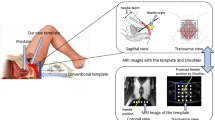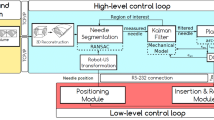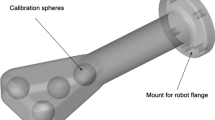Abstract
Purpose
We present a new method for flexible needle and patient localization in interventional CT procedures based on fractional CT scanning. Our method accurately localizes the trajectory of a flexible needle to which a spherical marker is attached at a known distance from the tip with respect to a baseline scan of patient in the CT scanner coordinate frame.
Methods
The localization is achieved with a significantly lower dose compared to a full scan using sparse view angle sampling and without reconstructing the CT image of the repeat scan. Our method starts by performing rigid registration between the patient and the baseline scan in 3D Radon space computed from the sparse projection data. It then computes 2D projection difference images in which the flexible needle and the spherical marker appear as prominent features. Their 3D spatial locations are then automatically extracted from the projection images to accurately trace the flexible needle trajectory. To validate our method, we conducted registration and needle trajectory localization experiments in seven abdomen phantom scans using a short and a long flexible needle.
Results
Our experimental results yield a mean needle trajectory localization error of 0.7 ± 0.2 mm and a mean tip localization error of 2.4 ± 0.9 mm with a \(\times \)7.5 radiation dose reduction with respect to a full CT scan.
Conclusions
The significant radiation dose reduction enables more frequent needle trajectory localization during the needle insertion for a similar total dose, or a reduced total dose for the same localization frequency.



Similar content being viewed by others
References
Gupta R, Walsh C, Wang IS, Kachelrieß M, Kuntz J, Bartling S (2014) CT-guided interventions: current practice and future directions. In: Jolesz FA (ed) Intraoperative imaging and image-guided therapy. Springer, New York, pp 173–191
Boas FE, Fleischmann D (2012) CT artifacts: causes and reduction techniques. Imaging Med 4(2):229–240
Mettler FA Jr, Wiest PW, Locken JA, Kelsey CA (2000) CT scanning: patterns of use and dose. J Radiol Prot 20(4):353
Chodick G, Ronckers CM, Shalev V, Ron E et al (2007) Excess lifetime cancer mortality risk attributable to radiation exposure from computed tomography examinations in children. IMAJ-RAMAT GAN- 9(8):584
Miller DL, Vañó E, Bartal G, Balter S, Dixon R, Padovani R, Schueler B, Cardella JF, De Baère T (2010) Occupational radiation protection in interventional radiology: a joint guideline of the Cardiovascular and Interventional Radiology Society of Europe and the Society of Interventional Radiology. Cardiovasc Interv Radiol 33(2):230–239
Sarti M, Brehmer WP, Gay SB (2012) Low-dose techniques in CT-guided interventions. Radiographics 32(4):1109–1119
Stoeckelhuber BM, Leibecke T, Schulz E, Melchert UH, Bergmann-Koester CU, Helmberger T, Gellissen J (2005) Radiation dose to the radiologist’s hand during continuous ct fluoroscopy-guided interventions. Cardiovasc Interv Radiol 28(5):589–594
Sheafor DH, Paulson EK, Kliewer MA, DeLong DM, Nelson RC (2000) Comparison of sonographic and CT guidance techniques: does CT fluoroscopy decrease procedure time? Am J Roentgenol 174(4):939–942
Orth RC, Wallace MJ, Kuo MD of the Society of Interventional Radiology TAC et al (2008) C-arm cone-beam CT: general principles and technical considerations for use in interventional radiology. J Vasc Interv Radiol 19(6):814–820
Siemens Healthcare (2018) syngo DynaCT. https://www.HrBhealthcare.siemens.com/angio/options-and-upgrades/clinical-softHrBware-applications/syngo-dynact/technical-details. Accessed 24 Oct 2018
Manduca A, Yu L, Trzasko JD, Khaylova N, Kofler JM, McCollough CM, Fletcher JG (2009) Projection space denoising with bilateral filtering and CT noise modeling for dose reduction in CT. Med Phys 36(11):4911–4919
Zhang Y, Wang Y, Zhang W, Lin F, Pu Y, Zhou J (2016) Statistical iterative reconstruction using adaptive fractional order regularization. Biomed Opt Express 7(3):1015–1029
Kim K, Ye JC, Worstell W, Ouyang J, Rakvongthai Y, El Fakhri G, Li Q (2015) Sparse-view spectral CT reconstruction using spectral patch-based low-rank penalty. IEEE Trans Med Imaging 34(3):748–760
Niu S, Gao Y, Bian Z, Huang J, Chen W, Yu G, Liang Z, Ma J (2014) Sparse-view X-ray CT reconstruction via total generalized variation regularization. Phys Med Biol 59(12):2997
Liu Y, Liang Z, Ma J, Lu H, Wang K, Zhang H, Moore W (2014) Total variation-stokes strategy for sparse-view X-ray CT image reconstruction. IEEE Trans Med Imaging 33(3):749–763
Medan G, Shamul N, Joskowicz L (2017) Sparse 3D Radon space rigid registration of CT scans: method and validation study. IEEE Trans Med Imaging 36(2):497–506
Medan G, Joskowicz L (2017) Reduced-dose imageless needle and patient tracking in interventional CT procedures. IEEE Trans Med Imaging 36(12):2449–2456
Wu G, Li X, Lehocky CA, Riviere CN (2013) Automatic steering of manually inserted needles. In: IEEE international conference on systems, man, and cybernetics (SMC), 2013. IEEE, pp 1488–1493
Engh JA, Minhas DS, Kondziolka D, Riviere CN (2010) Percutaneous intracerebral navigation by duty-cycled spinning of flexible bevel-tipped needles. Neurosurgery 67(4):1117–1123
Ben-David E, Shochat M, Roth I, Nissenbaum I, Sosna J, Goldberg SN (2018) Evaluation of a CT-guided robotic system for precise percutaneous needle insertion. J Vasc Interv Radiol 29:1440–1446
Glozman D, Shoham M (2007) Image-guided robotic flexible needle steering. IEEE Trans Robot 23(3):459–467
Vrooijink GJ, Abayazid M, Misra S (2013) Real-time three-dimensional flexible needle tracking using two-dimensional ultrasound. In: IEEE international conference on robotics and automation (ICRA), 2013. IEEE, pp 1688–1693
Marinetto E, Uneri A, De Silva T, Reaungamornrat S, Zbijewski W, Sisniega A, Vogt S, Kleinszig G, Pascau J, Siewerdsen J (2017) Integration of free-hand 3D ultrasound and mobile C-arm cone-beam CT: Feasibility and characterization for real-time guidance of needle insertion. Comput Med Imaging Graph 58:13–22
Huo B, Zhao X, Han J, Xu W (2015) Shape reconstruction and attitude estimation of bevel-tip needle via CT-guidance. In: IEEE international conference on robotics and biomimetics (ROBIO), 2015. IEEE, pp 620–625
Yaniv Z, Cheng P, Wilson E, Popa T, Lindisch D, Campos-Nanez E, Abeledo H, Watson V, Cleary K, Banovac F (2010) Needle-based interventions with the image-guided surgery toolkit (IGSTK): from phantoms to clinical trials. IEEE Trans Biomed Eng 57(4):922–933
Cong W, Yang J, Ai D, Chen Y, Liu Y, Wang Y (2015) Quantitative analysis of deformable model-based 3-D reconstruction of coronary artery from multiple angiograms. IEEE Trans Biomed Eng 62(8):2079–2090
Khan M (2012) A new method for video data compression by quadratic Bézier curve fitting. Signal Image Video Process 6(1):19–24
Adelman Z (2018) Reduced-dose region-of-interest image reconstruction in repeat ct scanning. Master Thesis, The Hebrew University of Jerusalem, Dec 2018
Acknowledgements
We thank Eyal Lin and Ronen Shter of GE Healthcare Israel for the CT scans and for their valuable assistance.
Author information
Authors and Affiliations
Corresponding author
Ethics declarations
Conflict of interest
The authors declare that they have no conflict of interest.
Human and animal rights
This article does not contain any studies with human participants or animals performed by any of the authors.
Additional information
Publisher's Note
Springer Nature remains neutral with regard to jurisdictional claims in published maps and institutional affiliations.
Research supported by Kamin Grant 57706, Office of the Chief Scientist, Ministry of Trade and Industry, Israel.
Rights and permissions
About this article
Cite this article
Medan, G., Joskowicz, L. Flexible needle and patient tracking using fractional scanning in interventional CT procedures. Int J CARS 14, 1039–1047 (2019). https://doi.org/10.1007/s11548-019-01945-x
Received:
Accepted:
Published:
Issue Date:
DOI: https://doi.org/10.1007/s11548-019-01945-x




